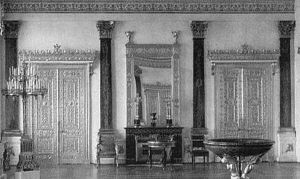| Revision as of 12:04, 5 May 2015 editGiano (talk | contribs)Autopatrolled, Extended confirmed users20,173 editsNo edit summary← Previous edit | Revision as of 15:23, 13 May 2015 edit undoSagaciousphil (talk | contribs)Autopatrolled, Extended confirmed users, Pending changes reviewers, Rollbackers22,311 edits formatting: 3x whitespace (using Advisor.js)Next edit → | ||
| Line 5: | Line 5: | ||
| The '''Malachite Room''' of the ], ], was designed in the late 1830s by the architect ] for use a formal reception room for the ], wife of ]. It replaced the ], which was destroyed in the fire of 1837. <ref>State Hermitage Museum</ref> | The '''Malachite Room''' of the ], ], was designed in the late 1830s by the architect ] for use a formal reception room for the ], wife of ]. It replaced the ], which was destroyed in the fire of 1837. <ref>State Hermitage Museum</ref> | ||
| The room obtains its name from the use of ] for its columns and fireplace. This large salon contains a large malachite ] as well as furniture from the workshops of Peter Gambs (1802-1871), son of the famous furniture maker ], which were rescued from the 1837 fire. |
The room obtains its name from the use of ] for its columns and fireplace. This large salon contains a large malachite ] as well as furniture from the workshops of Peter Gambs (1802-1871), son of the famous furniture maker ], which were rescued from the 1837 fire. | ||
| During the Tsarist era, the Malachite Room, which links the state rooms to the ], served as not only a state drawing room of the Tsaritsa, but also as a gathering place for the Imperial family before and during ]. <ref>Sitwell</ref> It was here that ] brides were traditionally dressed by the Tsarina before proceeding from the adjoining ] to their weddings in the ]. <ref>Maylusnas, p109.</ref> | During the Tsarist era, the Malachite Room, which links the state rooms to the ], served as not only a state drawing room of the Tsaritsa, but also as a gathering place for the Imperial family before and during ]. <ref>Sitwell</ref> It was here that ] brides were traditionally dressed by the Tsarina before proceeding from the adjoining ] to their weddings in the ]. <ref>Maylusnas, p109.</ref> | ||
| Line 19: | Line 19: | ||
| *{{cite book | *{{cite book | ||
| | last = Andrei Maylunas | | last = Andrei Maylunas | ||
| | first = Segei Mironenko |
| first = Segei Mironenko | ||
| | year = 1996 | | year = 1996 | ||
| | title = A Lifelong Passion | | title = A Lifelong Passion | ||
| | publisher = Orian Publishing Group Ltd |
| publisher = Orian Publishing Group Ltd | ||
| | location = London | | location = London | ||
| | id = ISBN 0-297-81520-2 | | id = ISBN 0-297-81520-2 | ||
Revision as of 15:23, 13 May 2015



The Malachite Room of the Winter Palace, St Petersburg, was designed in the late 1830s by the architect Alexander Briullov for use a formal reception room for the Empress Alexandra Fyodorovna, wife of Nicholas I. It replaced the Jasper Room, which was destroyed in the fire of 1837.
The room obtains its name from the use of malachite for its columns and fireplace. This large salon contains a large malachite urn as well as furniture from the workshops of Peter Gambs (1802-1871), son of the famous furniture maker Heinrich Gambs, which were rescued from the 1837 fire.
During the Tsarist era, the Malachite Room, which links the state rooms to the private rooms, served as not only a state drawing room of the Tsaritsa, but also as a gathering place for the Imperial family before and during official functions. It was here that Romanov brides were traditionally dressed by the Tsarina before proceeding from the adjoining Arabian Hall to their weddings in the Grand Church.
From June to October 1917 this room was the seat of the Russian Provisional Government. When the palace was stormed during the night of 7 November 1917, the members of the Government were arrested in the adjoining private dining room.
Today, as part of the State Hermitage Museum, this room retains its original decoration.
References
- State Hermitage Museum
- Sitwell
- Maylusnas, p109.
- Guardian
Further reading
- Andrei Maylunas, Segei Mironenko (1996). A Lifelong Passion. London: Orian Publishing Group Ltd. ISBN 0-297-81520-2.
- The Guardian newspaper's website. retrieved 20 April 2008. Published by the Guardian. (eye witness account of the storming of the Winter Palace).
- Valse des Fleurs by Sacheveral Sitwell retrieved 27 April 2008.
External links
- The Malachite Room today Flickr. Retrieved 13 November 2008.
| The Winter Palace | ||
|---|---|---|
| Rooms |  | |
| Miscellaneous | ||